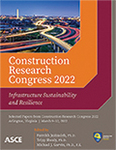Connecting Pre-Existing Characteristics of Water Utilities to Impacts during the COVID-19 Pandemic
Publication: Construction Research Congress 2022
ABSTRACT
The COVID-19 pandemic changed the way societies operate. Consequentially, the public, businesses, and industry used water differently, leading to changes in overall demand, along with spatial shifts in use. These changes stressed US water utilities, as they had to implement social distancing policies, adjust to changing revenues, and create customer assistance programs. The capabilities and characteristics of water utilities vary throughout the US, which may impact their resilience. Here, we aim to understand which pre-existing characteristics of water utilities may have led to resilience during the pandemic using results from a qualitative analysis of interviews with 27 US utilities conducted during 2020. We searched for statistical associations between utility characteristics (e.g., population dynamics, geographic location) and the challenges or changes experienced during the pandemic. Results of this study reveal the possible operating environments that increase the resilience of pandemic-induced shocks and help utilities prepare for future pandemics or population dynamics.
Get full access to this article
View all available purchase options and get full access to this chapter.
REFERENCES
AWWA and AMWA. (2020). The Financial Impact of the COVID-19 Crisis on U.S. Drinking Water Utilities.
Berglund, E. Z., Thelemaque, N., Spearing, L., Faust, K. M., Kaminsky, J., Sela, L., Goharian, E., Abokifa, A., Lee, J., Keck, J., and Giacomoni, M. (2021). “Water and Wastewater Systems and Utilities: Challenges and Opportunities during the COVID-19 Pandemic.” JWRPM, 147(5), 1–9.
Bigger, J., Willingham, M., Krimgold, F., and Mili, L. (2009). “Consequences of critical infrastructure interdependencies: lessons from the 2004 hurricane season in Florida.” International Journal of Critical Infrastructures, 5(3).
Casey, E. B. (2020). Pipe Market Turns to New Materials to Address Aging Water Infrastructure.
Cooley, H., Gleick, P. H., Abraham, S., and Cai, W. (2020). Water and the COVID-19 Pandemic.
Cotterill, S., Bunney, S., Lawson, E., Chisholm, A., Farmani, R., and Melville-Shreeve, P. (2020). “COVID‐19 and the water sector: Understanding impact, preparedness and resilience in the UK through a sector‐wide survey.” Water and Environment Journal.
Cutter, S. L., Ash, K. D., and Emrich, C. T. (2016). “Urban–Rural Differences in Disaster Resilience.” Annals of the American Association of Geographers, 106(6), 1236–1252.
Faust, K. M., Abraham, D. M., and DeLaurentis, D. (2017). “Coupled human and water infrastructure systems sector interdependencies: Framework evaluating the impact of cities experiencing urban decline.” JWRPM, 143(8).
Faust, K. M., Abraham, D. M., and McElmurry, S. P. (2015). “Water and Wastewater Infrastructure Management in Shrinking Cities.” Public Works Management and Policy, 21(2), 128–156.
Faust, K. M., and Kaminsky, J. A. (2017). “Building Water and Wastewater System Resilience to Disaster Migration: Utility Perspectives.” JCEM, 143(8), 04017058.
Kaminsky, J., and Faust, K. M. (2017). “Transitioning from a Human Right to an Infrastructure Service: Water, Wastewater, and Displaced Persons in Germany.” ES&T, 51(21), 12081–12088.
Leavitt, W. M., and Kiefer, J. J. (2006). “Infrastructure Interdependency and the Creation of a Normal Disaster: The Case of Hurricane Katrina and the City of New Orleans.” Public Works Management & Policy, 10(4), 306–314.
“MapChart.” (2021). MapChart, <mapchart.net>.
Matthews, J. C. (2016). “Disaster Resilience of Critical Water Infrastructure Systems.” Journal of Structural Engineering, 142(8), 1–4.
McDaniels, T., Chang, S., Cole, D., Mikawoz, J., and Longstaff, H. (2008). “Fostering resilience to extreme events within infrastructure systems: Characterizing decision contexts for mitigation and adaptation.” Global Environmental Change, Pergamon, 18(2), 310–318.
Morley, K. M. (2019). “What Makes a Utility Resilient?” Opflow, 45(8), 22–24.
Opdyke, A., Javernick-Will, A., and Koschmann, M. (2017). “Infrastructure hazard resilience trends: an analysis of 25 years of research.” Natural Hazards, 87(2), 773–789.
RCAP. (2020). The Impact of COVID-19 on Rural and Tribal Water and Wastewater Systems.
Saldana, J. (2013). The Coding Manual for Qualitative Researchers. Sage.
Spearing, L. A., and Faust, K. M. (2020). “Cascading System Impacts of the 2018 Camp Fire in California: The Interdependent Provision of Infrastructure Services to Displaced Populations.” International Journal of Disaster Risk Reduction, 50.
Spearing, L. A., Thelemaque, N., Kaminsky, J. A., Katz, L. E., Kinney, K. A., Kirisits, M. J., Sela, L., and Faust, K. M. (2020a). “Implications of Social Distancing Policies on Drinking Water Infrastructure: An Overview of the Challenges to and Responses of U.S. Utilities during the COVID-19 Pandemic.” Environmental Science & Technology Water, 1.
Spearing, L., Osman, K., Faust, K., and Armanios, D. E. (2020b). “Systems Vary, Affordability Should Not: Trends of Water Sector Affordability Based on City Attributes.” Construction Research Congress, Tempe, Arizona, 627–635.
US Census Bureau. (2010). Census regions and divisions of the United States.
US Census Bureau. (2020). Southern and Western Regions Experienced Rapid Growth This Decade.
US EPA. (2006). 2006 Community Water System Survey.
US EPA. (2020). “Small Drinking Water Research.” <https://www.epa.gov/water-research/small-drinking-water-systems-research>.
US EPA. (2021). “America’s Water Infrastructure Act: Risk Assessments and Emergency Response Plans.”, <https://www.epa.gov/waterresilience/awia-section-2013>.
Warner, M. E., Zhang, X., and Rivas, M. G. (2020). “Which states and cities protect residents from water shutoffs in the COVID-19 pandemic?” Utilities Policy, 67.
Washington, S. P., Karlaftis, M. G., and Mannering, F. (2010). Statistical and econometric methods for transportation data analysis. CRC Press, Boca Raton, FL.
Information & Authors
Information
Published In
History
Published online: Mar 7, 2022
Authors
Metrics & Citations
Metrics
Citations
Download citation
If you have the appropriate software installed, you can download article citation data to the citation manager of your choice. Simply select your manager software from the list below and click Download.
